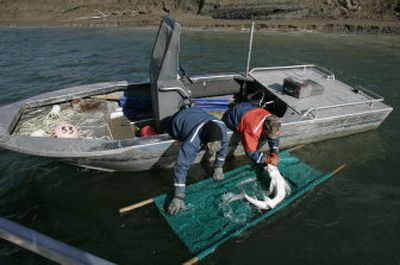Trying to save the sturgeon

BOISE — Each year, endangered white sturgeon lay millions of fertilized eggs on the silty bed of the Kootenai River where it curls across the top of Idaho.
Yet, experts estimate perhaps only 10 of the baby sturgeon hatched from those millions of eggs survive.
The white sturgeon, the largest freshwater fish in North America, has not successfully reproduced in the Kootenai River since Libby Dam was completed in Montana in 1974, reducing the river velocity and trapping critical nutrients upstream.
Downstream, however, pools at a hatchery run by the Kootenai Indian Tribe teem with thousands of year-old sturgeon, inch-long miniature replicas of the two armor-plated wild adults in another tank, each measuring 6 to 7 feet long. Another tank holds the medium-sized fish raised at the hatchery since birth, including a striking all-white sturgeon, a ghost of a prehistoric past.
Bred from captured wild sturgeon, the young sturgeon may represent the last hope biologists have of preventing extinction of the species.
“Old sturgeon don’t die – they just fade away,” said Sue Ireland, fish and wildlife program manager for the Kootenai Tribe. “Entire populations just fade away because people don’t realize there is no recruitment (additions to the number of spawning fish) going on.”
Over the past decade, the hatchery has released 80,000 juvenile sturgeon into the river. But because the fish don’t reach sexual maturity until about age 30, the oldest of those hatchery-raised sturgeon are not expected to begin spawning until 2025.
And the number of fish that will survive until that time will be significantly less than 80,000, says Bob Hallock, Kootenai white sturgeon recovery team leader for the U.S. Fish and Wild-life Service.
“The first year the fish are released, about 60 percent survive,” he said. “After that, the rate is about 90 percent annually. So you play that out over 30 years, and that’s not a lot of fish.”
Ireland says researchers are unsure whether the hatchery fish will return to the place they were born, as ocean-going salmon do, or spawn elsewhere along the only place they are found, a 167-mile stretch of river between Kootenai Falls in Montana across Idaho to Corra Linn Dam at the end of British Columbia’s Kootenay Lake.
“We don’t really know if they will come back,” Ireland said. “We’d like to start incubating and raising fish upstream, because if there is a specific homing instinct, maybe we should be raising them in the location we want them to return to.”
That location is an 18-mile section of the Kootenai River in Boundary County, Idaho, that was designated critical habitat for the white sturgeon by the U.S. Fish and Wildlife Service. The designation means federal and state agencies must consult with the federal agency before undertaking projects in that section of the river that might affect the sturgeon, declared an endangered species by the federal government in 1994.
The critical-habitat designation also means that Libby Dam operations must be modified to better replicate the higher, faster flows of the river before the dam was built. It is estimated that releasing more water from the dam to accommodate the sturgeon in the 18-mile section of the river will cost between $360 million and $780 million between now and 2025, when the first hatchery-bred sturgeon may start to spawn.
Most of the expenses estimated in a new draft economic analysis prepared for the Fish and Wildlife Service by a private consultant stem from modifications to Libby Dam to selectively release warmer water more conducive to spawning ($410 million) and from lost hydroelectric revenue ($300 million) from diverting water past power-generating turbines.
Biologists say the river is moving more slowly than it did prior to the dam’s construction, allowing silt to fill the river bottom and cover rock crevices where young sturgeon can hide from predators. Scientists believe increasing flows and velocity would clear out sand and silt from spawning beds, providing a gravelly place for fertilized eggs to incubate and giving cover to young sturgeon.
“The fish have been going to a certain location near Bonners Ferry and laying eggs, but they don’t have the substrate to adhere to,” said Tom Buckley, spokesman for the Fish and Wildlife Service in Spokane. “If we did have any successful hatching, right now there’s no place for the young fish to hide in that location.”
The Fish and Wildlife Service is proposing that the Army Corps of Engineers install rocks and gravel in the river downstream from Bonners Ferry to improve stur-geon spawning beds, along with potentially dredging and narrowing the channel while raising the riverbanks to increase water velocity through that section of the river.
Some of the habitat improvements will begin this summer. Planners with the Bonneville Power Administration and the Army Corps of Engineers have until April 14 to devise a strategy acceptable to the Fish and Wildlife Service to stop the steady demise of the estimated 500 remaining wild sturgeon, a number expected to dwindle to only 50 by 2030 unless scientists find a way to encourage successful reproduction.
“The question is: Are the thousands of hatchery fish we’ve released going to return to a habitat 30 years from now that is functional for reproduction?” said Hallock. “We still have 500 adults left, and we know a lot more about the biology of this species and the physical makeup of the river system than when we started, so we feel we can save this fish from extinction.”